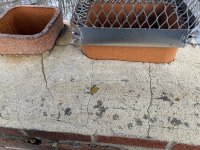- Joined
- Dec 28, 2014
- Messages
- 2,847
Hello,
I’m having a leak in my attic and it’s against the plywood where my chimney is on the other side. This ONLY is happening in winter. New roof (didn’t help), flashing (didn’t help).
Chimney inspection seemed to be at a loss for why this would happen. They looked down the heating side of the chimney (clay tile) and mortar was missing between the joints and some shifting. There are some cracks on the top of the chimney too, BUT it doesn’t leak in the summer even in hurricanes. Yet it leaks into the plywood every single day in winter.
I asked if perhaps condensation is getting through the mortar joints and behind the chimney, into the plywood. They didn’t seem convinced that was it. Yet they said I should get a metal sleeve down the chute anyway for safety and perhaps a stainless steel cap that will hang three inches out over the chimney. I was estimated $2,500 for the liner and $600 for the cap. Seemed like good guys.
Any thoughts? My thought is that the condensation is getting through and causing the plywood to get wet. But I’m not expert.
Here’s some pics of the attic.

I’m having a leak in my attic and it’s against the plywood where my chimney is on the other side. This ONLY is happening in winter. New roof (didn’t help), flashing (didn’t help).
Chimney inspection seemed to be at a loss for why this would happen. They looked down the heating side of the chimney (clay tile) and mortar was missing between the joints and some shifting. There are some cracks on the top of the chimney too, BUT it doesn’t leak in the summer even in hurricanes. Yet it leaks into the plywood every single day in winter.
I asked if perhaps condensation is getting through the mortar joints and behind the chimney, into the plywood. They didn’t seem convinced that was it. Yet they said I should get a metal sleeve down the chute anyway for safety and perhaps a stainless steel cap that will hang three inches out over the chimney. I was estimated $2,500 for the liner and $600 for the cap. Seemed like good guys.
Any thoughts? My thought is that the condensation is getting through and causing the plywood to get wet. But I’m not expert.
Here’s some pics of the attic.

